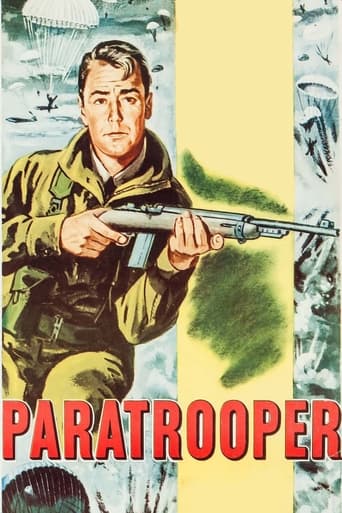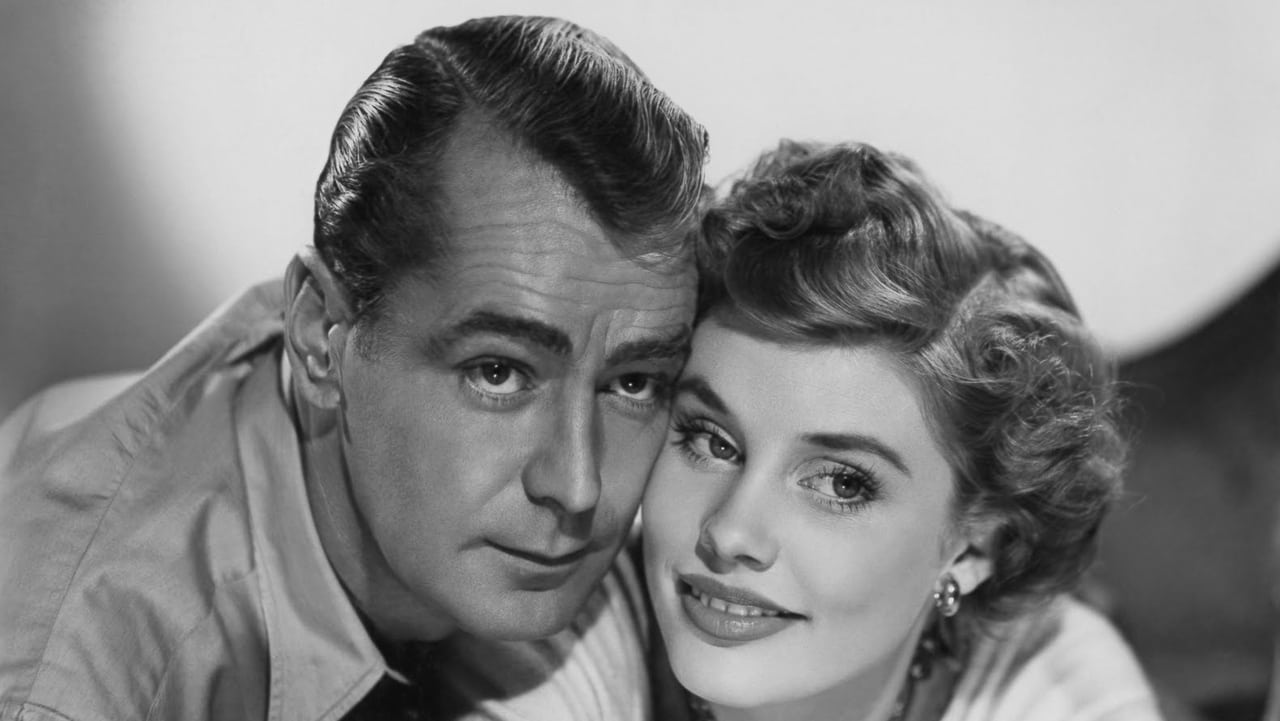SimonJack
This film is a very good look at the start of the British airborne forces during World War II. "Paratrooper" was released in America in late December 1953, more than four months after its early August premier in the U.K. where it was called "The Red Beret." That is the name of the book from which the film is adapted, written by Hillary St. George Saunders. Columbia studios clearly made the film for people on both sides of the pond. So, the plot includes an American who enlists in the British Army in Canada. That's OK, and we know quite a few American fliers joined the war effort early by serving in the RAF. Here it provides the love interest part of the film that Hollywood often included for wider audience appeal. But, I think any number of other actors might have filled the role better than Alan Ladd. His Private McKendrick (aka, "Canada") seemed to have a chip on his shoulder. We learn of his background halfway into the film, and one can understand his experience affecting him. But, not that he would be so touchy and angry toward other men. Whatever the reason, his character doesn't come across as genuine. That aside, I give this film eight stars for its interesting and early look at jump school training and the start of the British Airborne. Years later, I served as a paratrooper in the U.S. 504th and 509th Airborne regiments (1962 through 1964). Americans train at the Ft. Benning, GA, jump school. I became familiar with the British Airborne while stationed in what was then West Germany. We had NATO (North Atlantic Treaty Organization) military exercises in Europe with the Brits, West Germans, and others. And, I was in charge of our airborne PIO (Public Information Office) when we sent one of our troopers through the British jump school. He photographed and reported on it. And, yes, the Brits were still jumping from balloons in training. From its very beginning jump training has undergone changes, just as the aircraft, equipment and other things have changed. The film shows the first planes the Brits used. They were modified Wellington bombers and men dropped through an opening in the floor. Soon, "Dakotas" (Douglas C-47s) arrived from the U.S., and troopers jumped out of side doors behind the propellers. In 1962, I trained in C-119 "Flying Boxcars," and then jumped from C-130s (Hercules transports) and helicopters in Germany. The Brits needed to make seven jumps to earn their parachutist wings. We had to make five jumps in the U.S. The film shows training in hand-to-hand combat. Americans got that in advanced infantry training before Jump School. We don't see any other physical training in the film, but all paratroopers have much more rigorous physical conditioning. One thing was glaring to me – I didn't see a single trooper land with a PLF (parachute landing fall). Maybe this wasn't developed until well after the war, but PLF landing had tremendous results in reducing injuries. In a nutshell, the trooper is trained to turn or orient his chute for a side landing, and then in a relaxed position as his feet touch the ground, he rolls his body to the right or left, with his calf, then hip, then side absorbing the impact. In the 17 jumps I made, I only got hurt once, when I landed on a big boulder right in the middle of my back. In this movie, Stanley Baker plays one of the training cadre, Sgt. Breton. On the first airplane jump, his chute fails to open and he falls to his death. The Brits called his malfunction a Roman candle. In the American airborne, we call it a cigarette roll. But it's interesting that the Brits apparently didn't carry reserve chutes. They didn't appear to have them on in the film. So far as I know, American paratroopers always have had a reserve chute on the front. If anyone had a cigarette roll or other malfunction, he would release the main chute and pull the ripcord on his reserve. I saw half a dozen or more uses of the reserves in my airborne service. Some other things missing from this film were training jumps from towers. In one scene, I can see what looks like a 250-foot tower in the background. I also enjoyed the portrayal of the chute packing unit. It's too bad they didn't show the actual packing tables. And the funniest thing in this film is the strange looking headgear the Brits wore in jump school. "Paratrooper" is a good portrayal of the early action of the British Airborne. I thank Steve Crook from London, who's review tipped me off to the background of Major Snow. Leo Genn plays the part very well in this film. Snow was John Frost in real life. He became best known after his paratrooper battalion took the north end of the Arnhem Bridge in Operation Market Garden in September 1944. The Brits held out four days against a German Panzer division. They were captured only after they ran out of ammunition. In the 1977 blockbuster movie, "A Bridge Too Far," Anthony Hopkins plays Lt. Col. Frost beautifully. Frost retired as a Major General in 1968, and was a close adviser on that film. The only thing I see wrong in this movie is the name of the first operation the troopers had. Major Snow calls it "Operation Pegasus." In fact, it was called Operation Biting, also known as the Bruneval Raid. There was a real Operation Pegasus, and it was the escape plan across the Rhine River for many of the Brits trapped by the Germans in Operation Market Garden. War movie fans and those who like history especially should enjoy this film.
MartinHafer
From the onset, this movie starts with a serious deficit. Like too many Alan Ladd movies, it inexplicably has Ladd playing an angry man--too angry. He sulks and barks incessantly--like he's suffering from a bad case of PMS. While this sometimes works, here it just makes no sense. Even when you later learn about the supposed source of his anger, it still makes no sense. Having Ladd play a NON-CRAZY guy would have made this a better and more realistic film.Angry Alan has joined the Canadian Army and has volunteered for paratrooper duty. He's such a good soldier that they want to make him an officer but he refuses each time it is offered. Through the course of his training, he somehow gets a girlfriend--though what she see's in grouchy-boy, I don't know. The audience knows that despite his attitude, somehow Alan will make good by the end of the picture.In some ways this is a very good production and in others it's a disappointment. The paratroop scenes are very good and appear pretty realistic. Genuine American and British planes were used and the fights look nice as do the jumps. However, at other times it comes off poorly--because the little details were wrong. A few examples include post-WWII markings on an airplane (a minor problem but it should have been fixed) and a scene where the sky color changes back and forth in a sloppy manner. So, in a jump early in the film it's dusk and then looks about half an hour earlier and then half an hour later. Again, not a huge problem but seeing the change so quickly was baffling. The final odd thing is a common cliché--but a dumb one. Again and again you see guys pulling the pins from grenades WITH THEIR TEETH! This is a great way to lose teeth--and no one really ever did this--yet you see it in films repeatedly.As a result of some decent action, wooden characters (especially Ladd) and a few flubs, I think this is in the category of 'time-passer' and nothing more. Even if Albert Broccoli, Terrence Young and a lot of other future James Bond film crew worked on this, it's only average at best.
Spikeopath
The Red Beret (AKA Paratrooper) is directed by Terence Young and stars Alan Ladd & Leo Genn. It is based on the book of the same name written by Hilary Saint George Saunders. "This story tells of one small part of the war. The story of those men who joined the parachute regiment — Men from many different countries and creeds, who were to find themselves one day in a parachute training establishment. Only in the telling and in the spirit of these men themselves do history and fiction meet — even if we dare not show in this film what some of these men did in fact and in real life achieve. For nobody would ever believe it." Somewhere in England. The year 1940 after Dunkirk.A rather popular film at the Worldwide box office on release, this in spite of some British complaints about American actor Ladd playing the lead in a British war story, The Red Beret is serviceable as an action character piece. The story is in effect a play on real war hero John Frost, who is here played by Genn as Major Snow (Frost was portrayed by Anthony Hopkins in A Bridge Too Far). With this in mind it's obvious that Ladd, who does OK in his role of the reluctant leader, is purely there for American audience enticement. However, the makers do a good enough job of not letting Ladd's part in the film be the sole point of reference and detract from the real heroes from which the core of the film is based. There's some poor technical aspects to put up with, such as major superimposed sequences that stick out like a sore thumb, but these are off set a touch by the well constructed battle scenes. If in an undemanding war film mood this just about leaves a favourable impression. 6/10
Steve Crook
This is the thinly disguised story of real life hero John Frost. Portrayed in this film by Leo Genn and called Maj. Snow (I said the disguise was thin).Lt Col John Frost led the small group of paratroopers who actually got to the bridge in A Bridge Too Far (1977) (where he was played by Anthony Hopkins). Despite only having a few hundred men instead of the whole brigade that they expected to get there, they still held out for four days against an S.S. Panzer group. John Frost got his knees damaged by a mortar bomb so spent the rest of the war in a P.O.W. camp. In this film Maj. Snow gets wounded in the legs by a grenade but is carried to safety by his men.But Arnhem was just the final move in an amazing wartime career. Frost was one of the earliest volunteers in the newly formed parachute regiment at the start of the war. As a Major, he led the successful raid on the German radar station at Bruneval where radar specialist Sgt Cox (Sgt Box in this film) dismantled the German unit and brought it back to Britain along with some of the operators so that the British could understand the limits of the German radar system. This happened in a very similar way to the raid portrayed in the first part of the film.The next raid Frost led was on an airfield in Tunisia, just like the second raid in the film. In real life, as in the film, the raid on the airfield was a success but they had some problems getting back to their own lines.Frost then led the parachute drop on Sicily and a further raid in Italy before his wartime career finished at Arnhem.This film is quite well made and adapts the story well to fit Alan Ladd in without making it too obvious that he's only there to attract an American audience. The real heroes of this story are John Frost and the men of the Parachute Regiment.


 AD
AD

